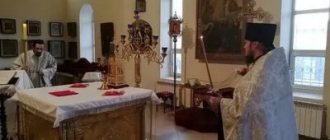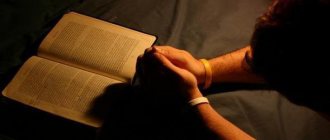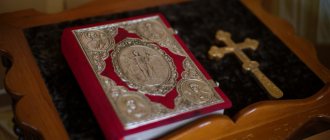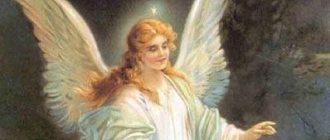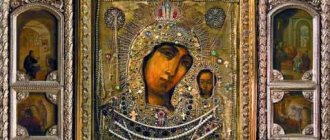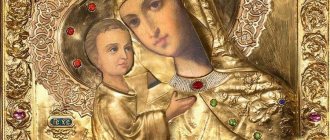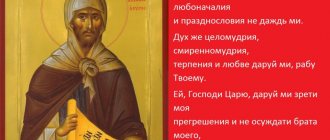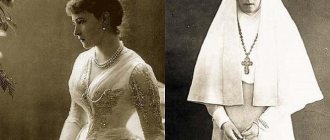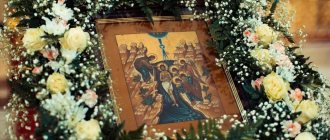On the correct performance of entrance prayers before the Liturgy
In our modern Missal, the main attention before the celebration of the Divine Liturgy is focused on the internal state of the clergy, and not their external appearance: “Even if a priest performs the Divine Act, he must first be reconciled with everyone and not have anything against anyone, and the heart has great strength , guard against evil thoughts, abstain in the evening and be sober even until the time of the sacred rite. When the time has come, he enters the temple and, uniting with the deacon, performs three adorations to the east before the holy doors” (see: Service Book, Rite of the Sacred Liturgy, Sequence of Entrance Prayers). As we see here, there is no indication at all of any clothing, be it a cassock or a kamilavka, and the epitrachelion is generally put on by the priest only immediately before performing Proskomedia (see: Service Book, Rite of the Sacred Liturgy, Sequence of Vestments).
But on this issue, explanations are given in the “Church Bulletin”: “The entrance prayers, as their very name shows, must be said before entering the altar, so that the one who pronounces them does not, it is assumed, have the opportunity to put on the epitrachelion. That is why, even in the case when the entrance to the holy altar is built directly from the street, and not through the temple, the priests make the entrance without an epitrachelion. If you take the service book, you can see that the priest places the epitrachelion on himself after laying on the surplice (i.e., the vestment) with the reading of the prayer: “Blessed be God, pour out grace...” (Ts. V-to 1900, No. 24).” . And then the answer to the question is repeated again: “Should entrance prayers be performed in the epitrachelion, or without it? The entrance prayers themselves are some preparation of the clergyman for entering the holy altar to perform the most important of the sacred rites, and, therefore, even if the clergyman entered the temple through the altar, there is no reason to put on an epitrachelion to perform the entrance prayers (Ts. V-to 1899 No. 6)" (Collection of solutions to perplexing questions from pastoral practice. Issue 1. K., 1903. P. 43−44).
The same opinion with similar argumentation is given by other compilers of practical manuals (See: S. Bulgakov. Handbook for priests and church ministers. T. I. M. 1993. P. 886; Valery Lukyanov, protopresbyter. Liturgical notes. Experience explanations of the practical side of the divine service of the Orthodox Church. Georgeanville, 2001. P. 144; Spiridon (Lukich), Archimandrite Proskomedia or Practical Guide for the Celebration of the Divine Liturgy. M., 2001. P. 8; Orthodox Divine Service. A practical guide for clergy and laity. Compiled by: I. V. Gaslov, A. S. Kashkin. St. Petersburg, 2002. P. 75; Tikhomirov T. S., priest. At the parish. M, 2002. P. 169).
Likewise, in the “Handbook of the Clergyman” it is indicated that “they read the entrance prayers, that is, preparatory prayers for the celebration of the liturgy (standing with their heads covered, in a skufya or kamilavka, before reading the troparion “To Your Most Pure Image...”). But then a note is nevertheless made: “According to established practice, the clergyman who has prepared to celebrate the liturgy enters the altar, makes two prostrations or bows before the throne according to the Rule, kisses it, makes a third bow, puts on the epitrachelion, removes the veil from the throne and the northern door leaves the altar on the sole to perform entrance prayers. If several clergy are performing the liturgy, then the eldest puts on an epitrachelion, the rest - in cassocks” (Handbook of a Clergyman. M., 1992. Vol. 1. P. 206).
Priest T. S. Tikhomirov expresses bewilderment about this: “It is difficult to say what led to the rooting of this essentially illogical custom” (Tikhomirov T. S., priest. At the parish. M, 2002. P. 169). Archim. Spiridon (Lukich) explains this by saying that “Obviously, the arrangement of entrances to the altar through the “sexton” created this incorrect practice” (Spiridon (Lukich), archimandrite. Proskomedia or Practical Guide for the Celebration of the Divine Liturgy. M., 2001. P. 8 ). From these comments it becomes clear that the custom of performing entrance prayers in stoles still existed earlier, although it was considered unjustified and contrary to the instructions of the Service Book.
But why then did such a discrepancy arise between the instructions of the Service Book and the established liturgical practice?
The fact is that in the Russian Church, before the correction of the Service Book under Patriarch Nikon in 1655, the practice of performing entrance prayers was not the same and could differ both in its composition and in the method of performing them.
Thus, in the oldest Greek manuscripts known to us, the Euchologia, there are no entrance prayers at all, and in the statutes of the Liturgy of the 12th-15th centuries. As an entrance, usually only the prayer “Lord, send down your hand...” is given and of course there are no indications of vestments in the stole (See: Missal from Venice 1519 (Liturgical part). Reprint. Omsk-Uppsala, 2012 P. 6 ; Missal from Targovishte 1508. Reprint. Omsk-Uppsala, 2012. P. 8−9; Odintsov N. The order of public and private worship in ancient Russia until the 16th century. St. Petersburg, 1881. P. 56−57). This is due to the fact that the entrance prayers in their meaning and content are similar to the home rule before Holy Communion, but unlike it they are performed in the church and therefore are already considered part of the service (Entrance prayers / Deacon Mikhail Zheltov // Orthodox Encyclopedia. Vol. 10 M., 2004, p. 51).
In the XV-XVI centuries. a whole series of additions appeared and the rite of the Divine Liturgy in Rus' became more complicated. Thus, in the 14th century, entrance prayers appeared, that is, prayers that were supposed to be read by the priest at the entrance to the church before the celebration of the Liturgy. But these prayers constituted an exception in the liturgical practice of the Russian Church from the general order established in previous centuries and are found only in two service books that have survived to us from the 14th century, and, moreover, combined with prayers prescribed to be read before the Liturgy in the previous time. According to one of these Missals, the priest, entering the church, had to read: “Rejoice, door of God...” and “The impenetrable door, secretly signified, blessed Mother of God...”; Arriving at the royal doors: “To your most pure image...”, and entering the altar, he had to read Psalms 14 and 22, “The Trisagion and Our Father”, “Lord have mercy on us...”, “Glory even now”, “The source of mercy... "and troparions of the daily saint and the temple. (Odintsov N. The order of public and private worship in ancient Russia until the 16th century. St. Petersburg, 1881. P. 115−116).
Subsequently, the entrance prayers sharply lengthen, and their duration becomes comparable in time to the duration of the entire Liturgy, and therefore part of them had to be read by the clergy on the way to the temple. So in the 15th century. At least nine troparia and prayers of twenty or even more are added to the entrance prayers. This led to great diversity in the presentation of the rite in manuscripts, as well as to the fact that the rite of entrance prayers gradually turned into 2 independent ones - the rite of entering the temple and the rite of entering the altar (Dmitrievsky A. A. Divine services in the Russian church in the 16th century. Ch 1. Services of the weekly and annual circle and the order of the sacraments (Kazan, 1884, pp. 57−74).
The Hundred-Glavy Council (1551) decided to unify the ranks, and this succession (Chapter 9) was included in the first printed Russian Service Books and was used until the reforms of the Middle Ages. XVII century It consists of 2 parts, before the entrance to the temple and in the temple, and has a complex order. Part 1 includes the prayers “The Voice of Joy” and “My Feet Are Shed,” as well as Ps. 14 and 22, “It is worthy to eat” and dismissal. By the 2nd part, the priest is DRESSED IN EPITRACHIL and stands with the deacon in front of the iconostasis; the usual beginning is followed by the troparia “Rejoice at the door of God...”, “Under your mercy we take refuge...”, etc. (Dmitrievsky A.A. Divine service in the Russian church. P. 66−67. Cf.: Service Book. M., 1602 ; Service Book. M., 1627; Service Book. M., 1633; Service Book. M., 1640; Service Book. M., 1602; 1651)
But despite the resolution of the Council, the difference in practice remained and in parallel there was another custom: to read the entrance without any troparions (and most likely without vestments, since there are no indications in this regard), or only some prayers and even only one “Lord, send down your hand..." (Odintsov. The order of public and private worship. P. 199; Dmitrievsky A. A. Worship in the Russian Church. P. 57)).
During the liturgical reforms of Ser. XVII century Nikon's edition of the Service Book was based on the southwestern Russian (and not Moscow) tradition, and corrections were made according to the Euchologia of the Venetian edition. Thus, the main text for the newly revised Service Book of 1655 was mostly taken from the Stryatinsky Service Book of 1604 by Lviv Bishop Gideon Balaban, and some edits were made from the Service Books published in Kiev by the archimandrites of the Kiev-Pechersk Lavra Elisha Pletenetsky in 1620 and Peter (Mogila) in 1629 (Dmitrievsky A.A. Correction of liturgical books under Patriarch Nikon and subsequent patriarchs. M., 2004. P. 60−61). The order of entrance prayers is in accordance with these Service Books and was brought into full compliance with that set out in Greek early printed publications: that is, it consists of only one part, which is performed in front of the royal doors and without mention of putting on the epitrachelion. This is how this rite remains to this day in the Slavic and Greek Churches.
So, it is more likely that the custom of performing entrance prayers in the stole in our liturgical practice is an echo of that ancient pre-reform tradition that was preserved in Edinoverie and Old Believer practice, and also partly in the bishop’s service (Entrance prayers / Deacon Mikhail Zheltov // Orthodox Encyclopedia. Vol. 10. M., 2004. P. 52).
And given the absence of any clear instructions on this issue in the Service Book, as well as the confirmation of this practice not only by oral tradition, but also by old printed Service Books, it is quite acceptable for the priest to put on an epitrachelion when performing entrance prayers. By the way, in the Orthodox Encyclopedia, the modern practice of performing entrance prayers is described with the vestment of the priest in the stole (Entrance prayers / Deacon Mikhail Zheltov // Orthodox Encyclopedia. T. 10. M., 2004. P. 52). If a given church adheres to the tradition of reading entrance prayers without an epitrachelion, then it should not be rejected as contrary to generally accepted practice, just as such a tradition not only does not contradict the Service Book, but also has its confirmation in more ancient liturgical books.
orari
(ώραριον) - part of the vestments of a subdeacon, deacon and archdeacon, a kind of long ribbon, which the first wears crosswise over the shoulders, the second - on the left shoulder, and during the liturgy, after the "Our Father" the third is girded crosswise on the left shoulder, having its ends connected under right hand. Only in the Resurrection (“New Jerusalem”) Monastery the deacon wears an O. in the likeness of the archdeacon, as is practiced in Jerusalem. - Initially, in the ancient church, O. was a shawl that was put on the shoulders and served as an accessory for all Christians during prayer, as an imitation of the Jewish custom of using a veil during prayer; this is proven by comparing the image of Zechariah, the father of the Baptist (in the “menology” of Vasily), with the fresco image of the apostle. Peter and Paul in Rome (see Buonarotti). It is assumed that this particular clothing is meant in the apocalypse, when it speaks of the elders who prostrated themselves in prayer before the Lamb and wore white vestments (IV, 4). In related artistic depictions in the Roman catacombs, this clothing is represented as covering not only the shoulders, but also the arms; this was the appearance of those praying in ancient times and among the pagans (as can be seen from the testimonies of Ovid and Plautus, as well as from the image in the Vatican of the Gibeonite ambassadors mentioned in the book of Judges). It is not known exactly when O. became the vestment of exclusively clergy; in this capacity it is already mentioned by the most ancient writers, under the name either oranum or stola. Initially, in the pagan world, orarium was used in the sense of sudarium, strophium, linteolum, i.e. in the sense of a handkerchief. St. Ambrose mentions O. in the same sense when he says that the Christians of his time placed O. on the graves of Gervagius and Protasius, through which these O. received healing powers. During times of persecution, Christians fed O. with the blood of martyrs so that this shrine would not remain on earth (Pontius, in the biography of Cyprian). The very word O., according to the interpretation of Balsamon and Vlastar, comes from όράω - video, observe - and indicates that those who had O. were obliged to observe the course of the service and indicate what should be done at one time or another him, the people present in the church. Others produce ωράριον from ώρα - storage, care (for the souls of believers). Western archaeologists, focusing on Latin. the word orarium, deriving it from orare - to pray. The Fourth Council of Toledo, Bede the Venerable, Raban the Maurus and others produce orarium from oro in the sense of speaking, preaching, suggesting that O. belonged to the clergy, as church teachers.
N. B—v.
Story
In ancient times, such clothing was known under various names (for example, στιχάριον, alba, tunic). Almost all of these names meant the usual underwear worn by men and women in ancient times. The Christian Church accepted this clothing as sacred, following the example of the Old Testament priestly clothing, known as the tunic, or among the high priests - the podir.
The surplice was in general use in all ancient churches. In ancient times, the surplice was made of linen and was white, as indicated by one of its names - alba (white clothing). This color of the surplice, like the color of angelic robes, corresponds to the mysterious sign that the teachers of the church associate with it. The surplice signifies the bright life of those who put it on, reminds of the purity and immaculateness with which the servants of God must carry out their high service, and expresses their spiritual joy in the Lord, inspired by the purity of life. This sign is expressed in a prayer read when putting on the surplice: “My soul will rejoice in the Lord, for He has clothed me with the robe of salvation and clothed me with the robe of joy, just as you put a crown on a groom and adorned me with beauty like a bride.”
Use
The surplice is used by all three degrees of the priesthood, since the same purity of life is required of them. Subdeacons and, with the blessing of the bishop, altar servers, readers and singers also wear it. The surplice of a deacon (and clergyman) is a long robe with wide sleeves, with slits from the armpits to the bottom, fastened with buttons. The surplice is put on by the deacon over the cassock. The surplice symbolizes the garment of salvation (Isa. 61:10) and is sewn from light-colored material.
For the bishop and priests, the surplice is made wider and more spacious than the deacon's and is called the surplice, since it is located under the other vestments they wear. Sometimes ribbons are sewn on the sides and sleeves of the surplice, symbolizing the bonds with which Jesus Christ was bound before Caiaphas and Pilate, and the blood that flowed from His side. The cuts under the sleeves of the surplice are reminiscent of the pierced rib of Christ, and the mantles made of other materials or other colors signify the wounds from His scourging.
> See also
- Komzha for ministers and acolytes, and dalmatica for deacons - similar robes in Catholicism.
Easter [edit]
When the priest and deacon say their opening prayers before the Easter vigil, they say them while standing in front of the epitaphs (winding). The order is the same as usual, except that at the usual beginning they do not say the prayer “King of Heaven...”. This prayer is a Pentecostal hymn and therefore will not be repeated until this holiday.
During Bright Week - the week beginning on Easter (Easter Sunday) - the ritual is the same, except that the usual beginning is completely replaced by Easter hymns.
At the Hierarchical celebration of the Easter Divine Liturgy of Aksion Estin
replaced by Irmos of the Ninth Ode of the Paschal Canon:
Shine! Shine! O new Jerusalem! The glory of Lort has come upon you. Rejoice now and be glad, O Zion. Shine, pure Mother of God, in the Resurrection of Your Son.
